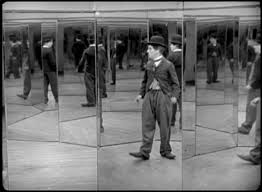by James Scott Bell
@jamesscottbell
 Once you wrap your head around the concept of the mirror moment, you’ll find them popping up all over the place.
Once you wrap your head around the concept of the mirror moment, you’ll find them popping up all over the place.
Quick review. At the midpoint of a novel or movie, you’ll usually find a moment within a scene when the Lead is forced to look himself. There are two kinds of looks: The “who am I?” look and the “I’m probably going to die” look.
The first is when there’s a character arc to the story, the Lead transforming over the course of the narrative. He is a different person at the end. Like Rick in Casablanca, who goes from sticking his neck out for nobody to a man willing to sacrifice his life for a greater good. The mirror moment is when he drunkenly insults the woman he loves, Ilsa, who has tried to explain to him why she left him in Paris. When she leaves, he has a moment (shown visually) of him thinking what a lousy bastard he is.
The second kind of mirror moment is when the Lead is fundamentally the same person at the end, but has been forced to grow stronger. Katniss Everdeen and Richard Kimble are examples of this type. They both have a moment in the middle where they are thinking I cannot possibly survive.
Now, in a series mystery you may have the type of Lead, the Sleuth, who doesn’t change fundamentally at the end of each book. Holmes, Poirot, Marple. Also, physical death may not be on the line.
In that case, you can make the mirror a “funhouse” kind, where everything looks confusing and distorted. Thus, you can always have your Lead considering the frustrating mix of clues that are just not adding up. Could this be the mystery that finally goes unsolved for our hero? (This is professional death for the sleuth).
I recently saw a funhouse mirror in Kiss Me, Deadly by Mickey Spillane. Mike Hammer is not your sensitive, New Age guy. So in the middle of the book Hammer is going over the case with his gal Friday (and love), Velda. She’s been gathering information, and lays it all out. It’s a funhouse mirror:
If ever there was a mess, this was it. Everything out of place and out of focus. The ends didn’t even try to meet. Meet? Hell, they were snarled up so completely nothing made any sense.
A funny side note. Once you’re aware of the mirror moment, you’ll find actual mirrors showing up. I was amused to find this on the very next page of Kiss Me, Deadly:
I went into a bar and had a beer while the facts settled down in my mind. While I sat there I tried to keep from looking at myself in the mirror behind the back bar but it didn’t work. My face wasn’t pretty at all. Not at all. So I moved to a booth in the back that had no mirrors.
So when you write a mystery, or a thriller with a mystery in it, you can always have your Lead, in the middle of things, thinking how nothing makes sense. More, how this is the biggest challenge of his life to date. Your readers will be right there with you, wanting to know how it will work out. Which it will, at the end, in satisfying fashion. Which is your best marketing tool, for as the Mick himself said, “The first chapter sells your book. The last chapter sells your next book.”
Comments and questions welcome.

 Half my life’s in books, written pages.
Half my life’s in books, written pages.